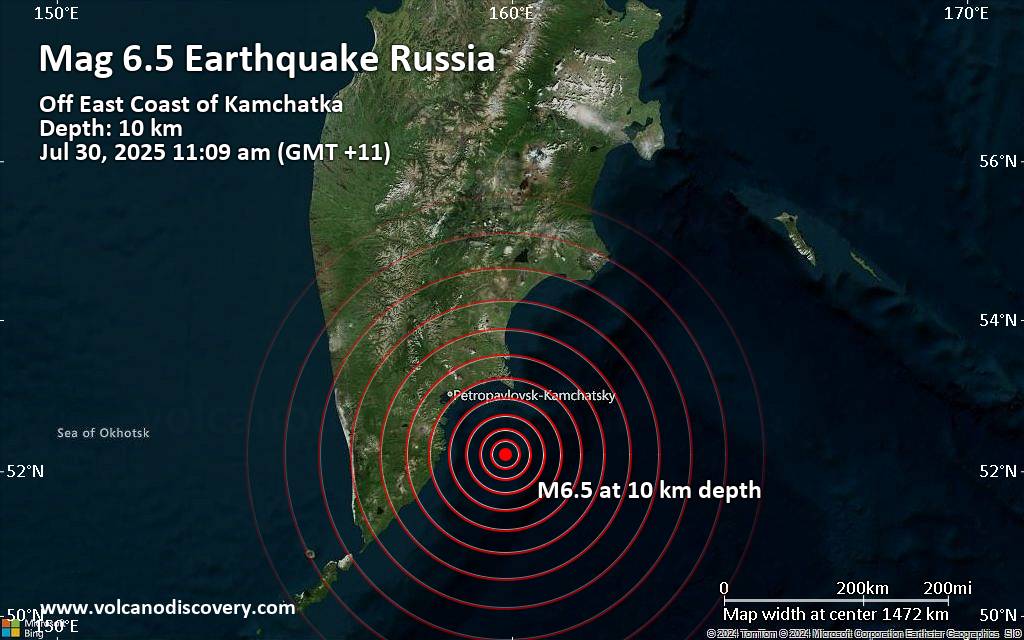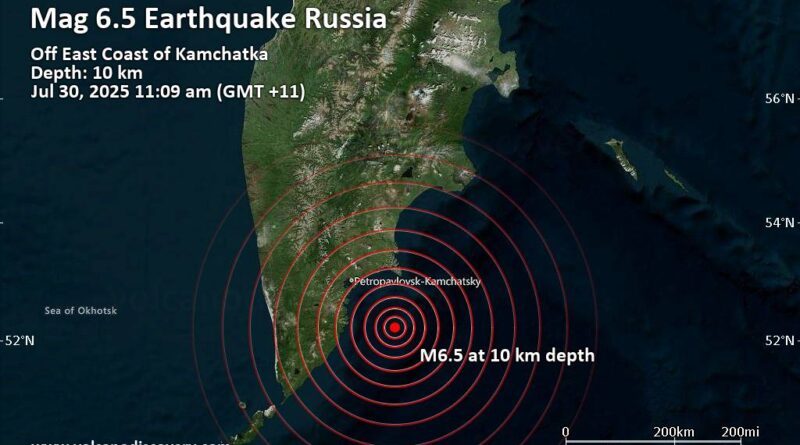From 7.4 to 8.8: How Kamchatka’s Foreshocks Set the Stage for Russia’s Biggest Quake in Decades
A look at how a July 20 magnitude‑7.4 quake and a cluster of tremors preceded Kamchatka’s massive 8.8‑magnitude earthquake—and what it says about seismic forecasting.

🔍 Prelude to Disaster: The Early Warning Signs
On July 20, a 7.4‑magnitude earthquake struck off Kamchatka’s coast, approximately 144 km east of Petropavlovsk‑Kamchatsky. It occurred at a depth of ~10–20 km and prompted tsunami alerts that were quickly lifted after further monitoring.
sfchronicle.comnews.abplive.com+2NewsRT – Real-Time News+2aljazeera.com+2
Minutes before and afterward, tremors of magnitude 6.7 and 5 + followed — part of a rapid cluster of seismic activity. Though no damage occurred this time, experts raised red flags: this was classic foreshock activity in a historic seismic zone.
aljazeera.comabc.net.aunews.abplive.com
⚠️ Why Foreshocks Matter
Megathrust earthquakes in subduction zones often follow a pattern: smaller quakes destabilize the fault until a catastrophic rupture occurs. The Kuril–Kamchatka trench—a convergence zone of the Pacific and North American plates—is infamous for this cycle.
RadioFreeEurope/RadioLibertyen.wikipedia.orgen.wikipedia.org
Scientists are now studying whether the 7.4 tremor on July 20 served as a harbinger — a missed chance at greater vigilance thousands of miles away.
The Washington PostThe Times of India
🌏 Historical Context & Precedents
Kamchatka has a violent seismic history:
- The 1952 Severo-Kurilsk quake (≈M9.0) triggered massive tsunamis that reached Hawaii (9 m high), yet reportedly caused no local casualties.
en.wikipedia.orgen.wikipedia.org - The 1923 and 1918 events similarly triggered deadly tsunamis, although impact was limited by sparse population.
en.wikipedia.orgen.wikipedia.org
These events highlight the regularity of huge ruptures in this region and the potential for early detection via foreshock clusters.
🧠 What Made This Sequence Different
Seismologists note:
- Rapid escalation: multiple magnitude 5–7 quakes occurred within hours before the 8.8 mainshock.
- Dense instrumental data allows refined analysis of stress build-up.
- Community alerts and seismic networks reduced casualties—but not damage.
Improved machine learning may now detect these patterns in real-time.
The Washington PostThe Times of India
👷♂️ Lessons for Preparedness & Monitoring
Early signals often go unnoticed. Experts recommend:
- Expanding seismic sensor networks across vulnerable zones.
- Establishing public alert thresholds (e.g. two 6.5+ tremors within hours) for readiness.
- Investing in tsunami evacuation infrastructure—signage, safe zones, drills.
Japan, Hawaii, and Alaska’s coordinated responses after the 8.8 quake show early warning systems can buy time—even if they don’t prevent destruction.
Wall Street JournalThe TimesThe Times of India
🌊 The Aftershock Challenge
As of reporting, over 24 significant aftershocks (≥ M5.0) occurred surrounding the rupture zone, including magnitudes 6.9 and 6.3, increasing tsunami concern and structural instability.
The Watchers
Monitoring continues in hopes of identifying patterns that could help predict the rare but inevitable next shock.
✍️ Conclusion
The Kamchatka sequence serves as a wake-up call: foreshocks are rarely isolated accidents—they may be nature’s warning. While forecasting remains inexact, improved seismic intelligence and preparedness can turn foreshocks into forewarnings.
If we listen carefully, tremors can speak truth—and save lives.
For the latest updates in tech, news, war, health, and more — keep reading Phinex News.

